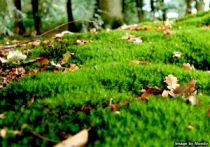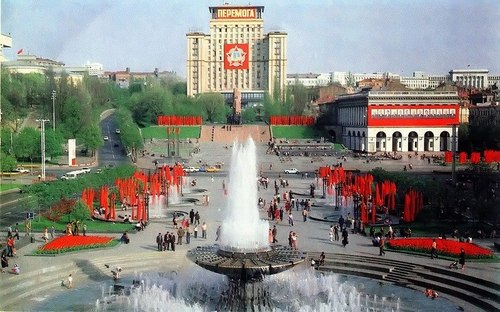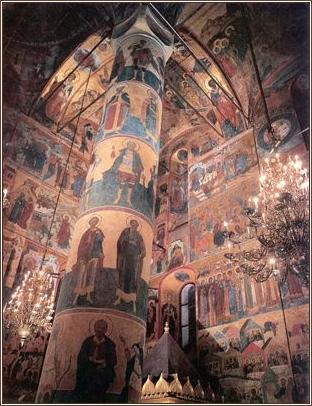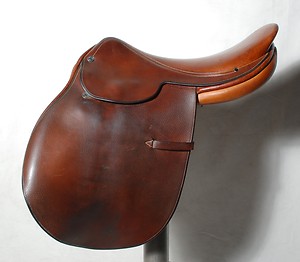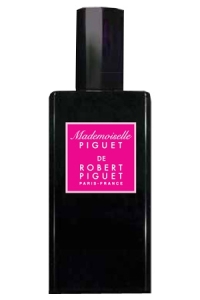When a small, relatively unknown perfume house makes one of your favorite fragrances in the world, you tend to root for it, and want to love all its creations. If the house comes with a fascinating history — complete with the notorious style icon, the Duchess of Windsor, as its most ardent fan — and if you’re a history fanatic, then you are even more compelled to want to like it. The reality, however, is that not all perfumes are created equal. And some fall short of the glory set by their siblings. That is the case with Oha, a lovely fragrance from the same house that created my beloved Alahine, but hardly a match for the latter’s spectacular, sophisticated, spicy, Oriental smolder.
Oha comes from the French perfume house, Téo Cabanel, founded in 1893 in Algeria by Théodore Cabanel. Upon moving to Paris, he developed over 150 different perfume formulae and soon came to the attention of high society. He was a favorite of the Duchess of Windsor — the woman for whom King Edward VIII famously gave up the English throne — and she refused to be without two of Cabanel’s fragrances (Julia and Yasmina), ordering bottles in massive quantities.
Unfortunately, over time, the house faded away, but it was essentially reborn in 2003 under the direction of Caroline Illacqua who had a distant connection to Cabanel’s daughter. Illacqua brought in the perfumer, Jean-Francois Latty, a very famous perfumer who created YSL for Men, YSL‘s Jazz, Givenchy III, Van Cleef & Arpel‘s Tsar and, allegedly, Drakkar Noir as well. (If so, I assume he worked alongside Pierre Wargnye who is usually credited with that famous men’s cologne). Latty now works solely as the in-house perfumer for Téo Cabanel.
 In 2005, the two released Oha, a floral chypre. According to the description on Téo Cabanel’s website, Oha’s notes include:
In 2005, the two released Oha, a floral chypre. According to the description on Téo Cabanel’s website, Oha’s notes include:
Bulgaria rose, Moroccan rose, tea notes, Egyptian jasmine, Guatemalan cardamom, vanilla, iris, tonka bean, woods, and white musk.
Some perfume sites have suggested other ingredients as well. The Sniffapalooza Magazine’s interview with Téo Cabanel’s new co-founder, Ms. Illacqua, states that there is bergamot as a top note. The perfume blog, I Smell Therefore I Am, thinks that there is patchouli as one of the base notes. I completely agree with both of them.
Téo Cabanel claims that the perfumes contain “100% pure and natural ingredients.” The company later clarified those remarks in the Sniffapalooza Magazine interview, stating that they “use between 85% and 95% of natural ingredients” to create their perfumes,” and that their musk and amber are synthetic by necessity due to animal cruelty issues. Ms. Illacqua elaborated further on the ingredients, as well as on the fact that the Cabanel signature is in using a duo of roses:
Téo Cabanel’s signature is to use 2 different types of roses: Bulgarian and Moroccan rose. We are one of the only brands to use two roses in a perfume. Natural ingredients are very expensive but give to the perfumes an incredible quality. Some of the ingredients we use:
- Rose – approximately 8000€/kg – we need 5000 kg of petals to produce 1kg of essence.
- Iris wax – the most expensive ingredient: between 10 000€ and 15 000€
- Bezoin: 7000€/kg
- Jasmine – one of the most delicate flower – only 5 to 6 tons of essence are produced per year which explains the price: between 6 000 € and 8 000 €/kg. [Formatting added.]
I quoted those figures to show, in part, the rich quality and non-synthetic feel of Oha. My other reason is that the vast quantities of rose and jasmine used by the company are the main, dominant feature of Oha.
In fact, at times, there doesn’t feel as though there is much more to the scent than rose and jasmine, atop a base of a mossy, green patchouli. There are a few subtle nuances (especially at the start), but, at the end of the day, Oha is just a very classique, elegant, increasingly abstract, generalized, amorphous “floral” in the chypre family.
It’s very pretty — but it doesn’t feel like anything special. It certainly didn’t bowl me over or become a slight obsession in the way that the glorious Alahine did. (I sometimes feel I should do another post dedicated solely to just how much I love Alahine, and how it surreptitiously and unexpectedly manages to sneak into your head after repeated wearings to become the most fascinating, obsession-inducing fragrance that you’ve encountered in a while.) But this is a post about Oha, so let’s get to it.

Purple rose at Warwick Castle, England. Photo provided with permission by CC from “Slightly Out of Sync” blog.
Oha opens as a mossy, bright, sparkling chypre. There is fresh, crisp lemon-tinged bergamot and light, green jasmine atop a lush rose base that is simultaneously jammy and fruity. It feels as though there is a light touch of the sweet tea rose to go with the main base of a rich, beefy, meaty, and very fleshy damask rose. You can almost see the thousands of kilos of blood-red petals that they must have used to create this. The richness of the rose base is undercut by the zesty citruses and a subtle undercurrent of light woodsy notes with a flicker of musk. And the whole thing is enveloped in a powerful embrace of oakmoss-like patchouli.
There is absolutely no question in my mind that Oha has patchouli in it. Téo Cabanel clearly used it in order to replicate the oakmoss that is usually the main foundational element for a chypre but which is now increasingly rare in perfumery due to IFRA/EU regulations. Here, the patchouli is not the dirty, dried, earthy, or black sort sometimes associated with the 1970s or hippies. Nor is it like modern patchouli that is purple-fruity in nature. Instead, it’s bright green, mossy, fresh and springy. It becomes significantly more pronounced at the thirty minute mark; and it remains for almost the entire duration of the scent, heavily intertwined with the floral notes to create the primary characteristic of the fragrance. At one point, it starts to feel a little dryer, but it never reaches the levels of true oakmoss with its often pungent, almost desiccated, arid, musty nature.
I never really detect any cardamon in Oha, but I sense its indirect effects as it lurks in the background. It helps to add a slight spiciness and fieriness to the main rose note, preventing it from being a simple fruity element. There is also a subtle tinge of muskiness underlying the scent. It never feels like cheap white musk, but a natural undertone to the flowers and patchouli.
An hour into Oha’s development, it is still primarily a rose-patchouli fragrance. There are strong citric undertones, but they can’t compete with the main duet. There are also flickers of something that feels like white woods but, like the musk, it is muted. The perfume which started out being quite strong in sillage drops in strength around this time, becoming significantly softer. By the 90 minute mark, it’s almost close to the skin, though Oha (which I keep writing as the Greek “Opa”) is quite strong when you bring your arm up to your nose.
The perfume changes around 2.5 hours into its development. It becomes quite abstract — by that, I mean that it becomes quite vague, generalized, almost amorphous in nature. You just get a general sense of a “floral with patchouli,” but there are no hugely distinct parts that are easily pulled out and separated. In part, it’s because Téo Cabanel fragrances are well-blended; in larger part, it’s because there really isn’t a hell of a lot to the scent. There aren’t layers and layers of depth — which is something that Alahine has in excess, God bless its little heart. Instead, Oha becomes a general floral that gives you the sense of some rose with perhaps a tinge of jasmine and something that feels a lot like peony. But the whole thing is swirled together to just read as “floral with patchouli.”
On occasion, different notes may briefly come to the surface. About four hours in, Oha suddenly turns very jasmine-y in nature, almost drowning out the roses. The jasmine is slightly musky, but never indolic, heady, sour or plastic-y. Then, Oha goes back to being amorphous until the 7th hour when there are flickers of a rooty, non-powdery, slightly earthy iris. That, too, quickly vanishes. By the end, midway during the 10th hour, Oha’s final traces are just simple, vague, musky “floral.” It died essentially as it lived — abstract, well-blended, elegant, and not incredibly special. Its sillage was always soft and well-mannered, noticeable if you actually smelled your arm, but never powerful or bold. The longevity was very good, given just how voraciously my skin consumes perfume.
Oha seems generally well-liked on Fragrantica, judging by the voting numbers. (There are certainly a lot more “Likes” than “Loves.”) But all comments about “sophistication,” elegance and “very French” feel incredibly lukewarm in the politest way possible. One commentator, “kterhark,” summed it up best, in my opinion:
Have you ever sat and flipped through channels at night, stumbling upon PBS where Charlotte Church was on stage, singing a pitch perfect operatic song, afterwhich everyone clapped politely?
That’s Oha.
But I prefer it when Mariah Carey or Celine Dion take the stage and belt it out. And this is my problem with Oha.
It’s subtle. Pitch perfect, but subtle. And as a chypre floral it is competing with some grand divas in my boudoir, like Caron’s Or et Noir and Guerlain’s Mitsouko pure parfum; and they are outsinging this one.
Nevertheless, I like this fragrance, it is indeed beautiful [.]
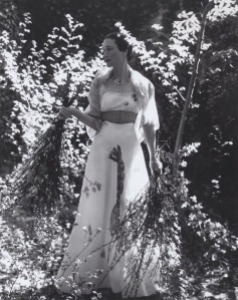
The Duchess of Windsor wearing the famous “Lobster Dress,” designed by Elsa Elsa Schiaparelli and Salvador Dali.
It pains me to write about how underwhelmed I was, because Oha actually is pretty. (I think “beautiful” may be pushing it a little.) It feels incredibly French and classique. It never evokes the supremely fashionable, trend-setting, iconic Duchess of Windsor, but, rather, a perfectly well-dressed, elegant French woman who doesn’t stand out from the crowd. She isn’t dripping with diamonds or furs; she isn’t even in a particularly sexy black dress or wearing the latest trend. She certainly isn’t making a scene or acting like a diva! She’s far from frumpy, she’d definitely not ugly or unattractive, and when you see her, you just know she’s French with impeccably well-bred bones and breeding. But, unless you were really, really looking at her, I’m not sure you’d notice her with her expertly cut, expensive, but completely innocuous dark suit, her expensive but unshowy handbag,her restrained chignon, her simple but expensive strand of pearls, and that quiet dab of muted lipstick. I passed by hundreds of such women in my years in Paris, and I’m sure they would wear Oha.
It’s not a negative thing in the slightest. But it’s not me. I’m not one for amorphous, abstract floral chypres without a particularly distinctive character — no matter how well-bred and classique they may be. That said, if you like floral chypres, I do think Oha is worth a sniff because it does have elegant bones and is an incredibly practical, versatile fragrance. This is something you could just spray on and go, without much thought; it would work pretty much everywhere and for all occasions, from an appointment at your child’s school, to a dinner with friends. Its discreet nature, while still being moderately strong on your actual skin, would also make it practical for the office. And you’d definitely feel feminine while wearing it. Plus, Téo Cabanel fragrances can be purchased for a relative steal on numerous discount sites (not to mention eBay).
I’m still disappointed, though. And I think the Duchess of Windsor would be, too. Now, if you’ll excuse me, I have to put on some of my beloved Alahine.



